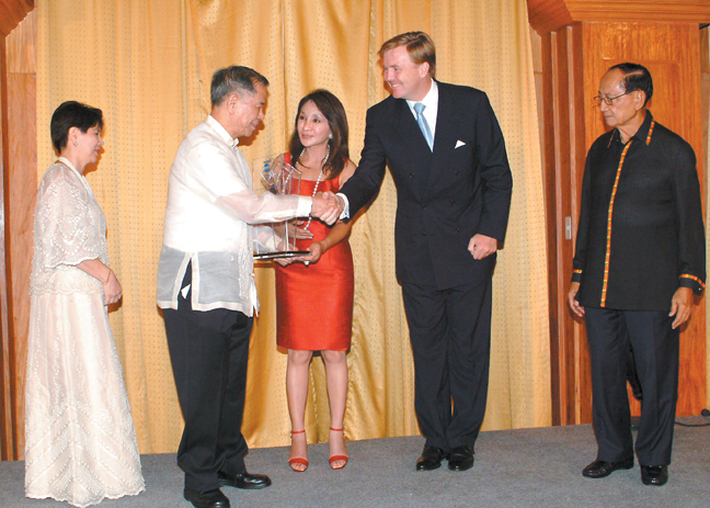For his pioneering efforts in constructing and rehabilitating small water dams for irrigation, Tan Yan Kee chairman Dr. Lucio C. Tan was conferred the Eco-award for Water Sustainability during the 8th Asia Pacific Roundtable for Sustainable Consumption and Production (APRSCP) held in Cebu City.
A key agricultural initiative of Dr. Tan, Fortune Tobacco Corp. and the Tan Yan Kee Foundation, the construction and/or rehabilitation of small water ponds has a three-fold aim: 1) fresh water conservation; 2) productivity enhancement; and 3) provision of livelihood.
To date, seven water impounding projects in Ilocos Norte, Ilocos Sur, La Union and Cagayan Province have been constructed. The small dams have a combined capacity of nearly one million cubic meters of fresh water which can irrigate farmlands during the long summer months. More dams are expected to be built in 2009.
Dr. Tan’s novel project was such a huge success that it caught the attention of the APRSCP organizing committee that was scheduled to hold this year’s summit in Cebu City, Philippines.
His Royal Highness Prince Willem-Alexander of the Netherlands, who chairs the UN Secretary General’s Advisory Board on Water and Sanitation, was guest of honor and speaker. Together with former president Fidel V. Ramos, Cebu Governor Gwendolyn Garcia and APRSCP president Olivia Castillo La’O, Prince Willem-Alexander personally conferred the award upon Dr. Tan.
Formed in 1997, the APRSCP is an international forum that fosters dialogue among industry, government, academia, and NGOs in the Asia Pacific region to address pollution, development problems and solutions. It has a strong network within the region.
Dr. Tan’s water impounding project began after he observed that water quality in Northern Luzon has deteriorated, thus rendering it unsuitable for plants, particularly rice, corn and tobacco.
A regular visitor to these areas, the taipan found it ironic that farmers depended too much on water from deep wells, whereas rainwater just flows to the sea during rainy months. He wondered whether there was a way of capturing and conserving this precious resource for use during dry spells.
While small reservoirs are the best facilities for storing huge volumes of rainwater, the once fully-functional irrigation dams built in the ‘70s could no longer effectively store enough fresh water due to wear and heavy siltation.
Assessing the problem, Dr. Tan sought the help of former agriculture secretary and now Sorsogon congressman Salvador H. Escudero III. Assisted by project director Richard Yao, Dr. Escudero began the arduous task of identifying and inspecting once operational irrigation dams.
Soil and water experts, engineers and agriculturists were commissioned to draw up plans and construct/rehabilitate water reservoirs. As Dr. Tan reviewed detailed engineering plans, he displayed a deep understanding of soil types, conditions and chemical compositions that would prevent water seepage.
Dr. Tan’s novel project was such a huge success that it caught the attention of the APRSCP organizing committee that was scheduled to hold this year’s summit in Cebu City, Philippines.
His Royal Highness Prince Willem-Alexander of the Netherlands, who chairs the UN Secretary General’s Advisory Board on Water and Sanitation, was guest of honor and speaker. Together with former president Fidel V. Ramos, Cebu Governor Gwendolyn Garcia and APRSCP president Olivia Castillo La’O, Prince Willem-Alexander personally conferred the award upon Dr. Tan.
Formed in 1997, the APRSCP is an international forum that fosters dialogue among industry, government, academia, and NGOs in the Asia Pacific region to address pollution, development problems and solutions. It has a strong network within the region.
Dr. Tan’s water impounding project began after he observed that water quality in Northern Luzon has deteriorated, thus rendering it unsuitable for plants, particularly rice, corn and tobacco.
A regular visitor to these areas, the taipan found it ironic that farmers depended too much on water from deep wells, whereas rainwater just flows to the sea during rainy months. He wondered whether there was a way of capturing and conserving this precious resource for use during dry spells.
While small reservoirs are the best facilities for storing huge volumes of rainwater, the once fully-functional irrigation dams built in the ‘70s could no longer effectively store enough fresh water due to wear and heavy siltation.
Assessing the problem, Dr. Tan sought the help of former agriculture secretary and now Sorsogon congressman Salvador H. Escudero III. Assisted by project director Richard Yao, Dr. Escudero began the arduous task of identifying and inspecting once operational irrigation dams.
Soil and water experts, engineers and agriculturists were commissioned to draw up plans and construct/rehabilitate water reservoirs. As Dr. Tan reviewed detailed engineering plans, he displayed a deep understanding of soil types, conditions and chemical compositions that would prevent water seepage.

